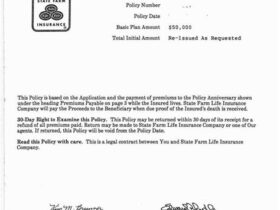Understanding insurance can often feel like navigating a complex maze, filled with unfamiliar terms and confusing calculations. Among these, the “insurance premium” stands out as a fundamental concept. This article aims to demystify what an insurance premium is, how it’s calculated, and how you can potentially lower your costs, empowering you to make more informed decisions about your coverage.
Defining the Insurance Premium
Simply put, an insurance premium is the amount you pay to an insurance company in exchange for coverage. Think of it as the price tag on the peace of mind that comes with knowing you’re financially protected against unforeseen events. This payment ensures that your insurance policy remains active and valid, safeguarding you against potential losses covered under the policy. Whether it’s auto, home, health, or life insurance, the premium is the cornerstone of your financial safety net.
How Insurance Premiums Work
The mechanics of an insurance premium are relatively straightforward. You, as the policyholder, agree to pay a specific amount at regular intervals – monthly, quarterly, semi-annually, or annually – to the insurance company. In return, the insurer commits to covering specific financial losses outlined in your policy, should they occur. Some insurers may require an upfront payment for each full year before any coverage starts.
Several factors influence how much you’ll pay for your premium, the policyholder’s age, location, claims history, and overall risk evaluation.
Key Factors Determining Your Insurance Premium
Insurance companies don’t pluck premium amounts out of thin air. They meticulously calculate them based on a variety of factors, assessing the risk they undertake by insuring you. These factors typically include:
Type of Coverage: The more comprehensive the coverage, the higher the premium. For example, an “all-risk” home insurance policy will cost more than a basic policy that only covers specific perils.
Amount of Coverage: The higher the coverage limit, the higher the premium. Insuring a house for $500,000 will invariably cost more than insuring it for $250,000. Similarly, opting for a lower deductible – the amount you pay out-of-pocket before insurance kicks in – will typically result in a higher premium.
Personal Information: Your personal history and circumstances play a significant role. This includes your age, driving record (for auto insurance), credit score, health conditions (for life and health insurance), and even your occupation. Insurance companies target specific demographics, tailoring their rates to attract particular client profiles. One company might focus on retirees, while another might target young families.
Location: Your geographic location significantly impacts your premium. Living in an area with a high crime rate, frequent natural disasters, or heavy traffic will likely result in higher insurance costs.
Competition: The level of competition among insurance companies in your area can also influence premiums. If multiple insurers are vying for your business, you’re more likely to find competitive rates.
The Role of Actuaries in Premium Calculation

Behind every insurance premium lies the work of actuaries. These professionals are risk assessment specialists who use mathematical and statistical models to analyze the likelihood of various risks and the associated costs. They factor in historical data, current trends, and future projections to determine how much an insurance company needs to charge to cover potential claims and remain profitable.
How Insurance Companies Use Your Premiums

Insurance companies don’t simply pocket your premiums. They pool the premiums collected from all policyholders to create a fund from which they can pay out claims. They also invest a portion of these funds to generate additional income, which helps to offset the cost of providing coverage and keep premiums competitive. The insurance company also has to collect the premiums and make sure it saves enough of that money in liquid assets to be able to pay the claims for its policyholders.
Strategies for Lowering Your Insurance Premiums
While you can’t control all the factors that influence your insurance premiums, you can take steps to potentially reduce your costs:
Shop Around: Don’t settle for the first quote you receive. Compare rates from multiple insurance companies to find the best deal.
Increase Your Deductible: Opting for a higher deductible can significantly lower your premium. However, ensure you can comfortably afford to pay that amount out-of-pocket should a claim arise.
Bundle Your Policies: Many insurers offer discounts if you bundle multiple policies, such as auto and home insurance.
Improve Your Credit Score: A good credit score can translate into lower premiums, particularly for auto and home insurance.
Maintain a Safe Driving Record: Avoiding accidents and traffic violations will help keep your auto insurance premiums down.
Install Security Systems: Installing a burglar alarm or other security system can lead to lower home insurance premiums, as insurers recognise alarms as an effective deterrent that reduces the risk of burglary and theft.
Ask About Discounts: Inquire about available discounts, such as those for safe drivers, students, seniors, or members of certain organizations.
Why Premiums Change
Insurance premiums are not static; they can fluctuate over time due to various factors. These include:
Increased Claims: If an insurance company experiences a higher-than-expected number of claims in a particular area or for a specific type of coverage, they may raise premiums to offset their losses.
Changes in Risk Factors: Changes in your personal circumstances, such as moving to a new location or incurring a traffic violation, can also impact your premium.
Market Conditions: Broader economic conditions, such as inflation or changes in interest rates, can influence insurance premiums.
Understanding insurance premiums empowers you to make informed decisions about protecting your assets and well-being. By understanding how premiums are calculated and exploring strategies to lower your costs, you can find the coverage that best suits your needs and budget.






Leave a Reply